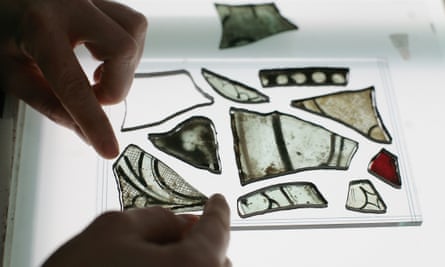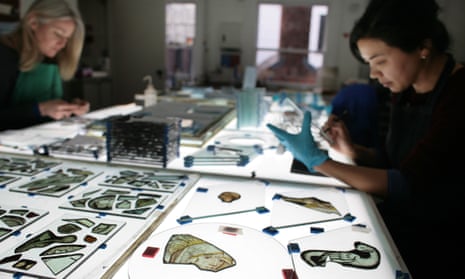When the archaeologist Warwick Rodwell scooped up a handful of dust from the attics of Westminster Abbey and saw dozens of tiny fragments of glass glittering in the grime, he realised they were dealing with excavation, not house clearance.
The salvaged glass – some dating back to the 13th century, including stars, flowers and sun rays, fierce little mythical animals and beautiful medieval faces – is being recycled into dazzling new windows being made for the abbey at the stained glass studio at Canterbury Cathedral, where some of the original medieval glass artists may have worked.
The Westminster attics, the triforium, were being cleared out to create a museum space opening next year. It will be the first time the general public has been admitted to the spectacular space.

Until the new tower, which will be lit by the new windows, was built outside the walls of Poets’ Corner, the only access was by a perilous, narrow spiral staircase used by centuries of workmen, and occasionally guests, and in the 20th century journalists, for great state occasions including coronations, royal weddings and funerals.
Rodwell said: “Once I saw the glass, the penny dropped. I realised this was treasure, not rubbish, and we would have to go through every inch of it. The workmen thought I was mad.”
The attics became one of the most unusual excavations anywhere: the diggers were working in pits up to 1.5 metres (5ft) deep, heavily masked to protect them from asbestos and lead dust, almost 30 metres above the floor of the abbey.

The cone-shaped pits were the upper sides of the vaulted ceiling, where layers of dust and rubbish had accumulated over 750 years, and the larger objects were sealed in when Sir Christopher Wren floored the space 300 years ago.
On Rodwell’s orders, everything including greasy London soot from the time of Henry III was brought down to ground level in buckets and hand-sorted by teams of archaeologists.
Rodwell, not a man for understatement, describes his excitement over the treasures as akin to Howard Carter finding the tomb of Tutankhamun.
His wonderful things include buttons and coins, the wrapper from a 17th-century pack of tobacco from a shop just outside the abbey walls, scraps of animal bone from workmen’s lunches, a medieval leather knife sheath, a 17th-century playing card, one patten – a 15th-century wooden and leather overshoe – and Rodwell’s favourite, invitations to the coronation of Queen Anne in 1702.
One was torn into four and dropped down between the floorboard, presumably in the long hours the ticket holder, Samuel Prat DD, spent hanging around waiting for something to happen.
Eventually, they had 30,000 pieces of glass, taken to the stained glass studio, which looks after Canterbury Cathedral’s acres of glass but also takes on conservation projects for churches across the country.

Leonie Seliger and her team cleaned, sorted and photographed every sliver from Westminster down to fragments the size of little finger nails. They were sorted by colours, and star objects including the exquisite 15th-century head of the Virgin, one tear sliding down her cheek as she watches the death of her son. One lovely painted head of a prophet is so close in style to a window in Canterbury that Seliger believes it has to be by the same master craftsman.
“There are puzzles upon puzzles upon puzzles,” Seliger said. “We have one piece of Victorian glass, all the rest is medieval including thousands of pieces of flower-painted grisaille from windows which nobody knew had been in the abbey – the 19th-century antiquarians who crawled all over the place made no reference to it, so they must have already vanished without trace by then.”
Laura Atkinson, who has been researching the glass, has found some pieces that must date back to windows installed for Henry III in the 13th century. She and Grace Ayson also managed to match some pieces, going back into the 30,000 photographs and managing to find the tail to accompany the head of one particularly vivid little 14th-century griffin. “It has been the best jigsaw puzzle in the world,” she said.
A unique display method has been created, matching the medieval scraps by shape and colour, but displaying each as a separate fragment slotted into a glass frame, then sandwiched in two more panels of clear glass. Behind them in the workshop, there is a stack of the modern glass panels they have cracked in the process.

Although the windows will be completed in spring for installation before the tower and the triforium open in June, research will continue for years on the finds.
Rodwell is left mourning all the rubbish cleared from other medieval churches, and Westminster itself, without any archaeological oversight.
“Here, the space over the chapels was cleared in the 1950s, and we found it clean as a whistle, not a dead spider left, and absolutely no record of what was found,” he said. “Heaven alone knows what treasures we have lost, but at least what we have done here will serve as a warning to other places not just to bin the lot.”




Comments (…)
Sign in or create your Guardian account to join the discussion